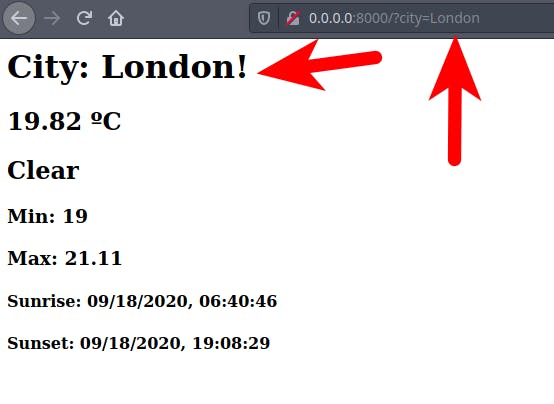In this tutorial, you'll learn how to unit test code that performs HTTP requests. In other words, you'll see the art of API unit testing in Python.
Unit tests are meant to test a single unit of behavior. In testing, a well-known rule of thumb is to isolate code that reaches external dependencies.
For instance, when testing a code that performs HTTP requests, it's recommended to replace the real call with a fake call during test time. This way, you can unit test it without performing a real HTTP request every time you run the test.
The question is, how can you isolate the code?
Hopefully, that's what I'm going to answer in this post! I'll not only show you how to do it but also weigh the pros and cons of three different approaches.
Requirements:
- Python 3.8
- pytest-mock
- requests
- flask
- responses
- VCR.py
Demo app using a weather REST API
To put this problem in context, imagine that you're building a weather app. This app uses a third-party weather REST API to retrieve weather information for a particular city. One of the requirements is to generate a simple HTML page, like the image below:

The weather in London, OpenWeatherMap. Image is the author's own.
To get the information about the weather, you must find it somewhere. Fortunately, OpenWeatherMap provides everything you need through its REST API service.
Ok, that's cool, but how can I use it?
You can get everything you need by sending a GET request to: https://api.openweathermap.org/data/2.5/weather?q={city_name}&appid={api_key}&units=metric. For this tutorial, I'll parameterize the city name and settle on the metric unit.
Retrieving the data
To retrieve the weather data, use requests. You can create a function that receives a city name as a parameter and returns a JSON. The JSON will contain the temperature, weather description, sunset, sunrise time, and so on.
The example below illustrates such a function:
def find_weather_for(city: str) -> dict:
"""Queries the weather API and returns the weather data for a particular city."""
url = API.format(city_name=city, api_key=API_KEY)
resp = requests.get(url)
return resp.json()The URL is made up of two global variables:
BASE_URL = "https://api.openweathermap.org/data/2.5/weather"
API = BASE_URL + "?q={city_name}&appid={api_key}&units=metric"The API returns a JSON in this format:
{
"coord": {
"lon": -0.13,
"lat": 51.51
},
"weather": [
{
"id": 800,
"main": "Clear",
"description": "clear sky",
"icon": "01d"
}
],
"base": "stations",
"main": {
"temp": 16.53,
"feels_like": 15.52,
"temp_min": 15,
"temp_max": 17.78,
"pressure": 1023,
"humidity": 72
},
"visibility": 10000,
"wind": {
"speed": 2.1,
"deg": 40
},
"clouds": {
"all": 0
},
"dt": 1600420164,
"sys": {
"type": 1,
"id": 1414,
"country": "GB",
"sunrise": 1600407646,
"sunset": 1600452509
},
"timezone": 3600,
"id": 2643743,
"name": "London",
"cod": 200The data is returned as a Python dictionary when you call resp.json(). In order to encapsulate all the details, you can represent them as a dataclass. This class has a factory method that gets the dictionary and returns a WeatherInfo instance.
This is good because you keep the representation stable. For example, if the API changes the way it structures the JSON, you can change the logic in just one place, the from_dict method. Other parts of the code won't be affected. You can even get information from different sources and combine them in the from_dict method!
@dataclass
class WeatherInfo:
temp: float
sunset: str
sunrise: str
temp_min: float
temp_max: float
desc: str
@classmethod
def from_dict(cls, data: dict) -> "WeatherInfo":
return cls(
temp=data["main"]["temp"],
temp_min=data["main"]["temp_min"],
temp_max=data["main"]["temp_max"],
desc=data["weather"][0]["main"],
sunset=format_date(data["sys"]["sunset"]),
sunrise=format_date(data["sys"]["sunrise"]),
)Now, you'll create a function called retrieve_weather. You'll use this function to call the API and return a WeatherInfo so you can build your HTML page.
def retrieve_weather(city: str) -> WeatherInfo:
"""Finds the weather for a city and returns a WeatherInfo instance."""
data = find_weather_for(city)
return WeatherInfo.from_dict(data)Good, you have the basic building blocks for our app. Before moving forward, unit test those functions.
1. Testing the API using mocks
According to Wikipedia, a mock object is an object that simulates the behavior of a real object by mimicking it. In Python, you can mock any object using the unittest.mock lib that is part of the standard library. To test the retrieve_weather function, you can then mock requests.get and return static data.
pytest-mock
For this tutorial, you'll use pytest as your testing framework of choice. The pytest library is very extensible through plugins. To accomplish our mocking goals, use pytest-mock. This plugin abstracts a bunch of setups from unittest.mock and makes your testing code very concise. If you are curious, I discuss more about it in another blog post.
Ok, enough talking, show me the code.
Here's a complete test case for the retrieve_weather function. This test uses two fixtures: One is the mocker fixture provided by the pytest-mock plugin. The other one is ours. It's just the static data you saved from a previous request.
@pytest.fixture()
def fake_weather_info():
"""Fixture that returns a static weather data."""
with open("tests/resources/weather.json") as f:
return json.load(f)def test_retrieve_weather_using_mocks(mocker, fake_weather_info):
"""Given a city name, test that a HTML report about the weather is generated
correctly."""
# Creates a fake requests response object
fake_resp = mocker.Mock()
# Mock the json method to return the static weather data
fake_resp.json = mocker.Mock(return_value=fake_weather_info)
# Mock the status code
fake_resp.status_code = HTTPStatus.OK
mocker.patch("weather_app.requests.get", return_value=fake_resp)
weather_info = retrieve_weather(city="London")
assert weather_info == WeatherInfo.from_dict(fake_weather_info)If you run the test, you get the following output:
============================= test session starts ==============================
...[omitted]...
tests/test_weather_app.py::test_retrieve_weather_using_mocks PASSED [100%]
============================== 1 passed in 0.20s ===============================
Process finished with exit code 0Great, your tests pass! But... Life is not a bed of roses. This test has pros and cons. I'll take a look at them.
Pros
Well, one pro already discussed is that by mocking the API's return, you make your tests easier. Isolate the communication with the API and make the test predictable. It will always return what you want.
Cons
As for cons, the problem is, what if you don't want to use requests anymore and decide to go with the standard library's urllib. Every time you change the implementation of find_weather_for, you will have to adapt the test. A good test doesn't change when your implementation changes. So, by mocking, you end up coupling your test with the implementation.
Also, another downside is the amount of setup you have to do before calling the function—at least three lines of code.
...
# Creates a fake requests response object
fake_resp = mocker.Mock()
# Mock the json method to return the static weather data
fake_resp.json = mocker.Mock(return_value=fake_weather_info)
# Mock the status code
fake_resp.status_code = HTTPStatus.OK
...Can I do better?
Yes, please, follow along. I'll see now how to improve it a bit.
Using responses
Mocking requests using the mocker feature has the downside of having a long setup. A good way to avoid that is to use a library that intercepts requests calls and patches them. There is more than one lib for that, but the simplest to me is responses. Let's see how to use it to replace mock.
@responses.activate
def test_retrieve_weather_using_responses(fake_weather_info):
"""Given a city name, test that a HTML report about the weather is generated
correctly."""
api_uri = API.format(city_name="London", api_key=API_KEY)
responses.add(responses.GET, api_uri, json=fake_weather_info, status=HTTPStatus.OK)
weather_info = retrieve_weather(city="London")
assert weather_info == WeatherInfo.from_dict(fake_weather_info)Again, this function makes use of our fake_weather_info fixture.
Next, run the test:
============================= test session starts ==============================
...
tests/test_weather_app.py::test_retrieve_weather_using_responses PASSED [100%]
============================== 1 passed in 0.19s ===============================Excellent! This test pass too. But... It's still not that great.
Pros
The good thing about using libraries like responses is that you don't need to patch requests ourselves. You save some setup by delegating the abstraction to the library. However, in case you haven't noticed, there are problems.
Cons
Again, the problem is, much like unittest.mock, your test is coupled to the implementation. If you replace requests, your test breaks.
2. Testing the API using an adapter
If by using mocks I couple our tests, what can I do?
Imagine the following scenario: Say that you can no longer use requests, and you'll have to replace it with urllib since it comes with Python. Not only that, you learned the lesson of not coupling test code with implementation, and you want to avoid that in the future. You want to replace urllib and not have to rewrite the tests.
It turns out you can abstract away the code that performs the GET request.
Really? How?
You can abstract it by using an adapter. The adapter is a design pattern used to encapsulate or wrap the interface of other classes and expose it as a new interface. This way, you can change the adapters without changing our code. For example, you can encapsulate the details about requests in our find_weather_for and expose it via a function that takes only the URL.
So, this:
def find_weather_for(city: str) -> dict:
"""Queries the weather API and returns the weather data for a particular city."""
url = API.format(city_name=city, api_key=API_KEY)
resp = requests.get(url)
return resp.json()Becomes this:
def find_weather_for(city: str) -> dict:
"""Queries the weather API and returns the weather data for a particular city."""
url = API.format(city_name=city, api_key=API_KEY)
return adapter(url)And the adapter becomes this:
def requests_adapter(url: str) -> dict:
resp = requests.get(url)
return resp.json()Now it's time to refactor our retrieve_weather function:
def retrieve_weather(city: str) -> WeatherInfo:
"""Finds the weather for a city and returns a WeatherInfo instance."""
data = find_weather_for(city, adapter=requests_adapter)
return WeatherInfo.from_dict(data)So, if you decide to change this implementation to one that uses urllib, just swap the adapters:
def urllib_adapter(url: str) -> dict:
"""An adapter that encapsulates urllib.urlopen"""
with urllib.request.urlopen(url) as response:
resp = response.read()
return json.loads(resp)def retrieve_weather(city: str) -> WeatherInfo:
"""Finds the weather for a city and returns a WeatherInfo instance."""
data = find_weather_for(city, adapter=urllib_adapter)
return WeatherInfo.from_dict(data)Ok, how about the tests?
To test retrieve_weather, just create a fake adapter that is used during test time:
@responses.activate
def test_retrieve_weather_using_adapter(
fake_weather_info,
):
def fake_adapter(url: str):
return fake_weather_info
weather_info = retrieve_weather(city="London", adapter=fake_adapter)
assert weather_info == WeatherInfo.from_dict(fake_weather_info)If you run the test you get:
============================= test session starts ==============================
tests/test_weather_app.py::test_retrieve_weather_using_adapter PASSED [100%]
============================== 1 passed in 0.22s ===============================Pros
The pro for this approach is that you successfully decoupled your test from the implementation. Use dependency injection to inject a fake adapter during test time. Also, you can swap the adapter at any time, including during runtime. You did all of this without changing the behavior.
Cons
The cons are that, since you're using a fake adapter for tests, if you introduce a bug in the adapter you employ in the implementation, your test won't catch it. For example, say that we pass a faulty parameter to requests, like this:
def requests_adapter(url: str) -> dict:
resp = requests.get(url, headers=<some broken headers>)
return resp.json()This adapter will fail in production, and the unit tests won't catch it. But truth to be told, you also have the same problem with the previous approach. That's why you always need to go beyond unit tests and also have integration tests. That being said, consider another option.
3. Testing the API using VCR.py
Now it's finally the time to discuss our last option. I have only found about it quite recently, frankly. I've been using mocks for a long time and always had some problems with them. VCR.py is a library that simplifies a lot of the tests that make HTTP requests.
It works by recording the HTTP interaction the first time you run the test as a flat YAML file called a cassette. Both the request and the response are serialized. When you run the test for the second time, VCR.py will intercept the call and return a response for the request made.
Now see how to test retrieve_weather using VCR.py below:
@vcr.use_cassette()
def test_retrieve_weather_using_vcr(fake_weather_info):
weather_info = retrieve_weather(city="London")
assert weather_info == WeatherInfo.from_dict(fake_weather_info)Wow, is that it? No setup? What is that @vcr.use_cassette()?
Yes, that's it! There is no setup, just a pytest annotation to tell VCR to intercept the call and save the cassette file.
What does the cassette file look like?
Good question. There's a bunch of things in it. This is because VCR saves every detail of the interaction.
interactions:
- request:
body: null
headers:
Accept:
- '*/*'
Accept-Encoding:
- gzip, deflate
Connection:
- keep-alive
User-Agent:
- python-requests/2.24.0
method: GET
uri: https://api.openweathermap.org/data/2.5/weather?q=London&appid=<YOUR API KEY HERE>&units=metric
response:
body:
string: '{"coord":{"lon":-0.13,"lat":51.51},"weather":[{"id":800,"main":"Clear","description":"clearsky","icon":"01d"}],"base":"stations","main":{"temp":16.53,"feels_like":15.52,"temp_min":15,"temp_max":17.78,"pressure":1023,"humidity":72},"visibility":10000,"wind":{"speed":2.1,"deg":40},"clouds":{"all":0},"dt":1600420164,"sys":{"type":1,"id":1414,"country":"GB","sunrise":1600407646,"sunset":1600452509},"timezone":3600,"id":2643743,"name":"London","cod":200}'
headers:
Access-Control-Allow-Credentials:
- 'true'
Access-Control-Allow-Methods:
- GET, POST
Access-Control-Allow-Origin:
- '*'
Connection:
- keep-alive
Content-Length:
- '454'
Content-Type:
- application/json; charset=utf-8
Date:
- Fri, 18 Sep 2020 10:53:25 GMT
Server:
- openresty
X-Cache-Key:
- /data/2.5/weather?q=london&units=metric
status:
code: 200
message: OK
version: 1That's a lot!
Indeed! The good thing is that you don't need to care much about it. VCR.py takes care of that for you.
Pros
Now, for the pros, I can list at least five things:
- No setup code.
- Tests remain isolated, so it's fast.
- Tests are deterministic.
- If you change the request, like by using incorrect headers, the test will fail.
- It's not coupled to the implementation, so you can swap the adapters, and the test will pass. The only thing that matters is that you request is the same.
Cons
Again, despite the enormous benefits compared to mocking, there are still problems.
If the API provider changes the format of the data for some reason, the test will still pass. Fortunately, this is not very frequent, and API providers usually version their APIs before introducing such breaking changes. Also, unit tests are not meant to access the external API, so there isn't much to do here.
Another thing to consider is having end-to-end tests in place. These tests will call the server every time it runs. As the name says, it's a more broad test and slow. They cover a lot more ground than unit tests. In fact, not every project will need to have them. So, in my view, VCR.py is more than enough for most people's needs.
Conclusion
This is it. I hope you've learned something useful today. Testing API client applications can be a bit daunting. Yet, when armed with the right tools and knowledge, you can tame the beast.
You can find the full app on my GitHub.
This article was originally published on the author's personal blog and has been adapted with permission.










1 Comment